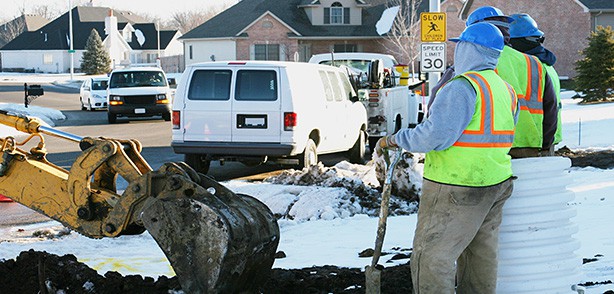January 28, 2019
A Construction Worker’s Guide to Working in Harsh Weather Conditions
It’s important that construction professionals (and anyone else who regularly works in the outdoors) are equipped with appropriate apparel for harsh weather conditions. Although the exact gear you need may differ, your approach to tackling big jobs in all extremes should be the same — protect yourself from the day’s weather so you can focus on the task at hand with minimal distractions.
Below, you’ll find tips on how to stay safe and comfortable in inclement weather conditions as a construction industry professional.

4 Core Pieces of Cold-Weather Gear
Staying warm on the job is vital to success, as it helps protect against frostbite, hypothermia, trench foot, and other forms of job-related cold stress. The best way to stay warm on the job is to invest in extreme cold apparel perfect for construction workers, including:- A Warm Work Coat or Insulated Coveralls – This should be your first and last line of defense against cold temperatures, wind, and snow. Choose a well-insulated winter work coat or a pair of durable coveralls that also have a tough outer layer that can stand up to demanding worksites. Choose one that doesn’t limit your range of movement, and always go for a high-visibility option to improve safety on the job.
- A Pair of Protective Work Gloves – Purchase warm construction gloves that suit your specific environment, whether you need a pair of leather gloves for working with sharp objects or some padded, protective gloves to keep you safe from impact injuries.
- Headwear That Fits Under Your Hard Hat – It’s probably a myth that most of our body heat is lost through the head, but that doesn’t mean you should ever go without a good winter hat. Choose one that fits comfortably beneath your protective headgear and doesn’t affect your ability to see.
- Warm and Properly Fitting Work Boots –Nothing will distract you from the job in front of you quite like cold or wet feet. The right work boots will help prevent trench (immersion) foot while also helping to ensure that you’re able to stay on your toes for long periods of time throughout the day.
What About Gear for Extreme Heat?
We tend to focus a lot of our attention on staying warm when temperatures are cold, but what about staying cool when temperatures are hot? Prolonged exposure to the hot sun is as dangerous as lengthy exposure to freezing temps, so you shouldn’t overlook this. The key to staying safe in hot weather is to wear lightweight, protective apparel—and don’t forget high visibility gear that protects you from damaging UV rays without weighing you down or compromising flexibility. Add lots of cold water and sunscreen, and you’ll be ready for a productive workday.
Knowing When It’s Too Cold or Hot to Work
Are there scenarios where it’s unsafe to work outside for long periods of time? Absolutely. Make sure that you’re not needlessly exposing yourself to high-risk environments and know that some laws may protect you from doing so. Don’t work outside if the temperature and wind chill factor have created a high or medium-risk environment for frostbite or if it’s too toasty to toil. In general, it’s best to work in environments that don't affect your internal body temperature (it should be around 98.6 degrees F).Quick Tips for Staying Comfortable (and Safe) on the Job
Dressing in a weather-appropriate manner and knowing when conditions are too harsh to work are the most important things you can do to ensure workplace safety amongst extreme conditions. Still, there’s a few more things you can do to keep comfortable while you work.- Bring Food and Beverages – To maintain an ideal body temperature, you should pay close attention to what you eat and drink. Certain foods —including hot soup, coffee, tea, and others — can help raise your body temp, while consuming cool liquids will help lower it.
- Take Frequent, Short Breaks –Whether it’s scorching hot or frigid cold, taking frequent breaks will help you maintain an even-keeled internal temp so you can stay comfortable. Regularly take breaks in cool areas when temps are high outside, and to warm areas if you need to warm up on winter workdays.
- Don’t Wear Thin or Worn Gear – Wearing apparel until it’s threadbare is a common yet often-overlooked mistake made by construction pros. If your gloves, coats, coveralls and other pieces of protective work apparel become threadbare, they lose their ability to insulate and protect. Don’t push to get extra mileage out of items that could prevent serious health problems, and always make sure to invest in quality gear that appropriately protects you.
- Retreat to Shelter —Temporary outdoor shelters like shade canopies and pop-up tents can help provide some relief from the elements. In the winter, equip your break tent with a tent-safe electric heater. In the summer, set up fans to get the breeze going.